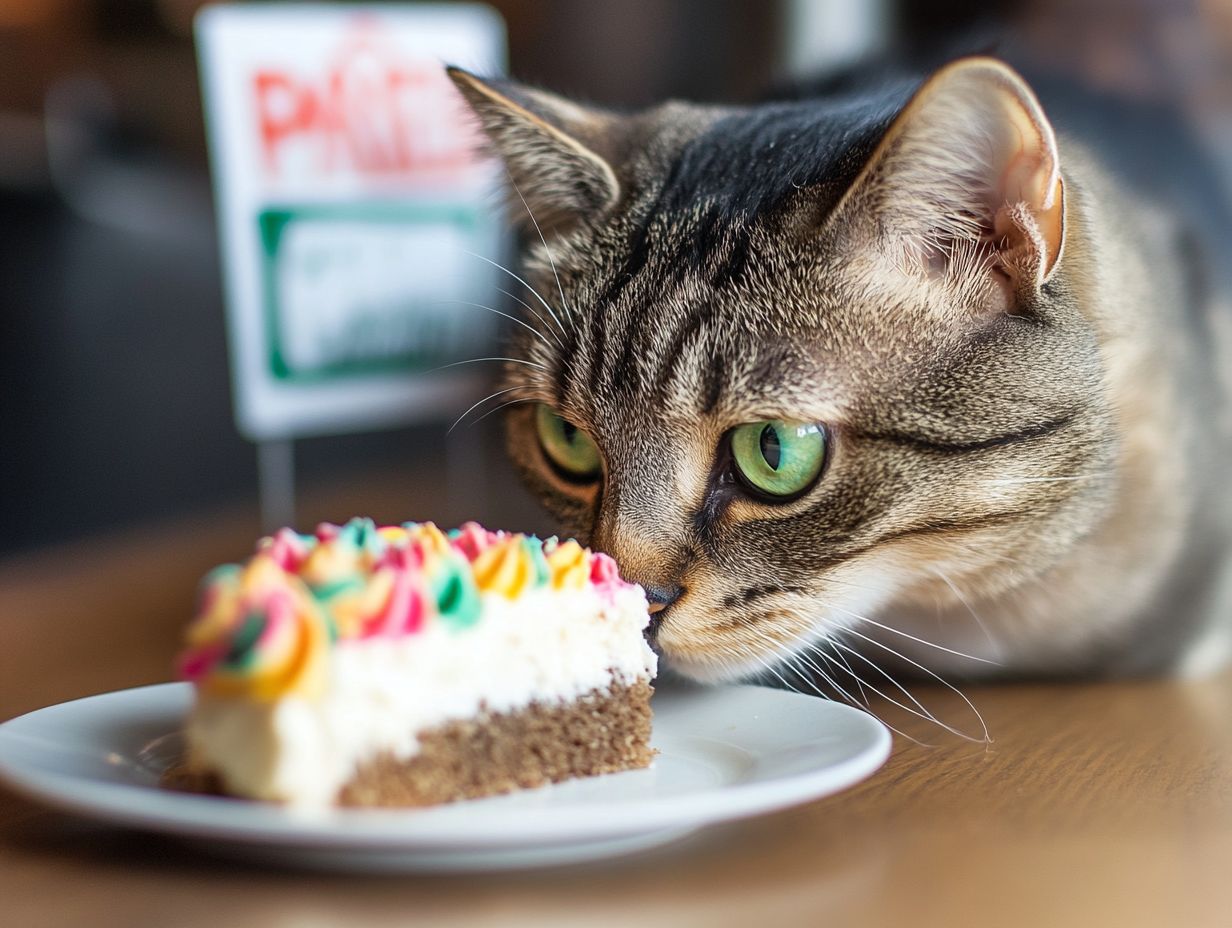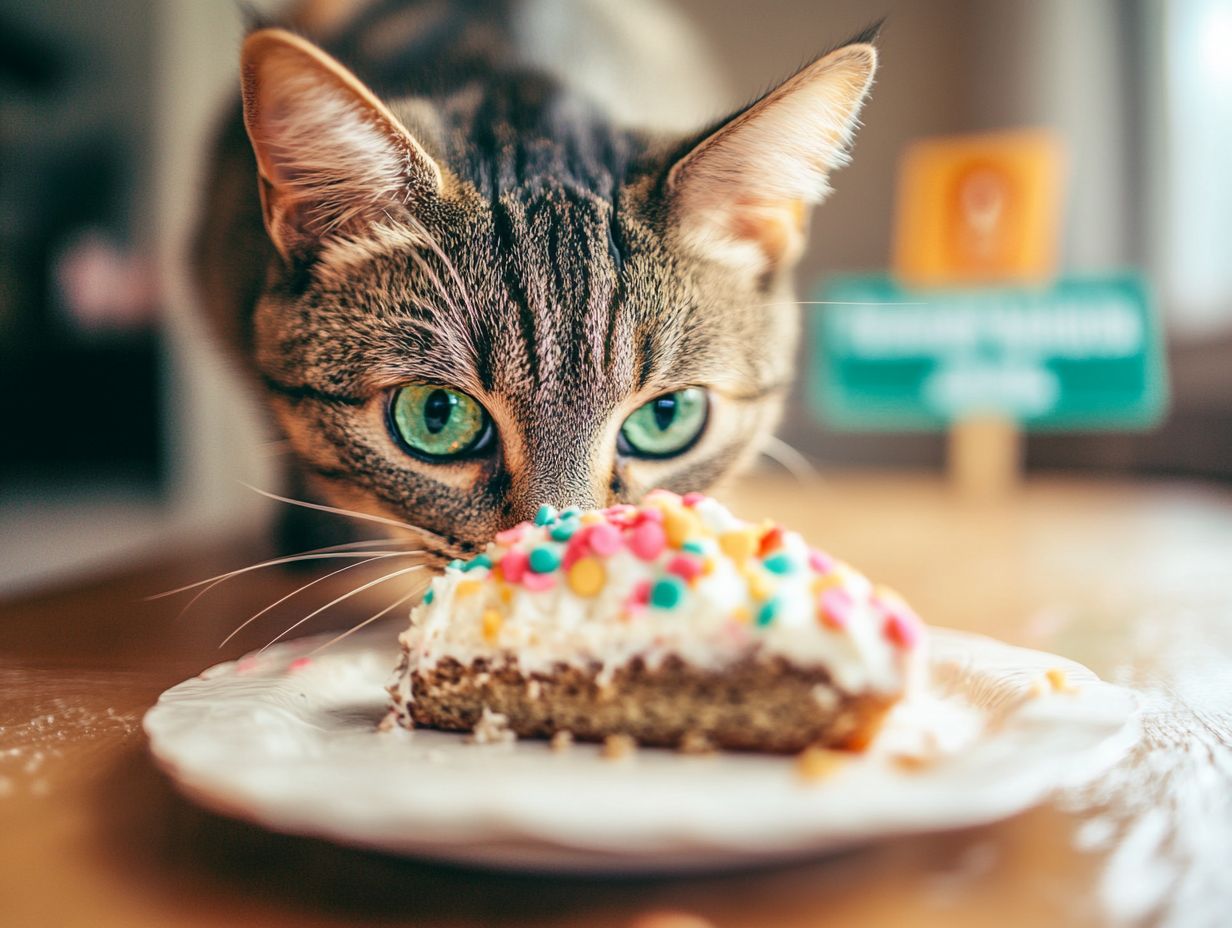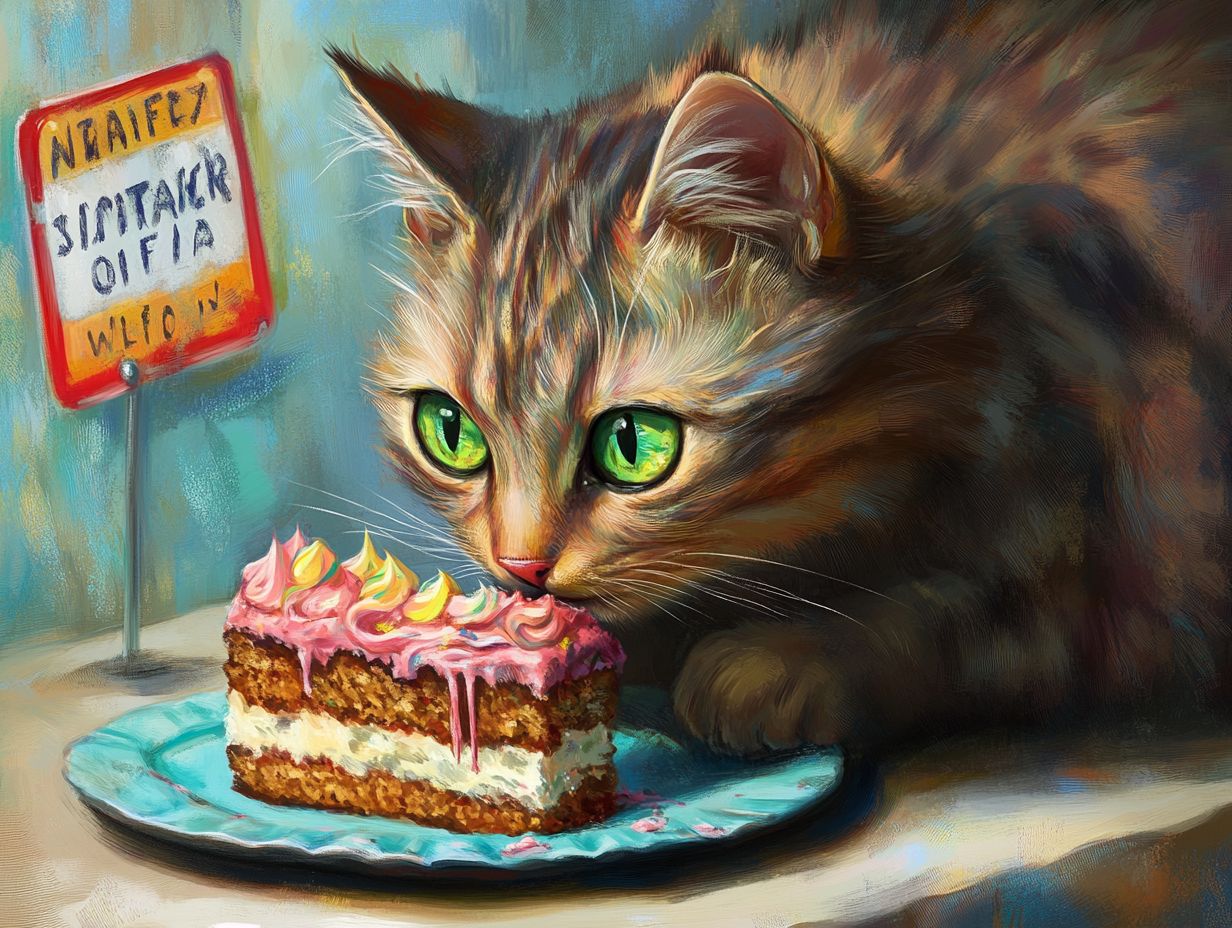Disclaimer: Always consult your veterinarian for personalized dietary advice, as every cat’s health needs may vary.
Curious about sharing your cake with your feline friend? The answer is: No, cake is harmful to cats. While a slice of vanilla or chocolate cake might seem like a fun treat, feeding cake to cats can lead to serious health problems such as obesity, diabetes, and pancreatitis. Instead of cake, consider offering small pieces of cooked chicken or fish as treats.
This piece explores the harmful ingredients commonly found in cakes, such as chocolate and macadamia nuts, safe alternatives your cat will enjoy, including fish and eggs, and practical tips to keep your kitty away from sugary temptations.
You’ll also learn what to do if your cat accidentally indulges in cake. Read on to ensure your beloved pet stays happy and healthy, avoiding unnecessary vet visits!
Key Takeaways:

- Cake can be harmful to cats due to its potential health risks, such as digestive issues and toxicity from common ingredients like chocolate and xylitol.
- It is important to avoid feeding cats cake and instead opt for safe and healthy treat options like cooked meats, fruits, and vegetables.
- Prevent your cat from consuming cake by keeping it out of reach, using deterrents such as citrus scents, and providing plenty of enrichment and proper nutrition.
The Dangers of Feeding Cake to Cats
Feeding cake to cats can harm their health and well-being. While many cat owners may view cakes as fun treats for celebrations, these foods can lead to serious health problems in felines.
Regular consumption of cake can contribute to obesity and diabetes, primarily due to its high carbohydrate content and potentially harmful ingredients that upset a cat’s digestive system. Moreover, cakes typically contain sugar and other components that can increase the risk of long-term health issues.
Potential Health Risks
Feeding cake to cats poses significant health risks, including obesity and diabetes, which can subsequently lead to more serious conditions such as pancreatitis, an inflammation of the pancreas. For more insights on this topic, check out this article from the AVMA. Symptoms of pancreatitis include vomiting, abdominal pain, and lethargy, often necessitating a visit to the veterinarian.
Therefore, it is essential to provide a balanced diet specifically designed for cats, ensuring they receive necessary nutrients without harmful ingredients.
Ingredients to Avoid in Cat Food
Identifying harmful ingredients in cat food is crucial to ensure the health and safety of your feline companions, as some commonly found components like milk, cream, and chocolate can be quite detrimental.
Common Cake Ingredients that are Harmful to Cats

Chocolate, dairy, sugar, and various spices are common cake ingredients that are toxic to cats. For instance, chocolate contains theobromine, which can lead to serious health issues. Even small amounts can cause symptoms like increased heart rate and restlessness, and in severe cases, seizures.
Dairy is commonly found in cakes and pastries in the form of cream, icing, and milk. However, a cat’s body lacks the necessary enzymes to break down lactose, resulting in gastrointestinal upset, including vomiting and diarrhea. Although dairy ingredients are typically present in small quantities, cats that consume cake regularly may be at risk of these adverse effects.
Spices such as nutmeg, lemon, and vanilla are often used in cakes and desserts. Nutmeg can cause hallucinations, nausea, and excessive thirst in cats. Lemon can lead to vomiting and diarrhea, while vanilla poses a risk due to its alcohol content.
Sugar, frequently added to enhance flavor, can disrupt a cat’s digestive system and contribute to obesity and diabetes over time. Since cats are not suited to consuming sweets, harmful ingredients can lead to excessive thirst, frequent urination, and lethargy.
Alternatives to Cake for Cats
Instead of cake, consider these safe alternatives for treats:
- Small pieces of cooked chicken (no seasoning), limited to no more than 10% of their daily food intake.
- Small pieces of cooked fish, like salmon or tuna, also limited to 10% of their daily food intake.
- Cooked eggs, scrambled with no additives, offered in small amounts.
Portion Sizes and Moderation Tips
When treating your cat with these alternatives, remember:
- Limit treats to no more than 10% of your cat’s daily caloric intake.
- Introduce new treats gradually to monitor for any adverse reactions.
What to Do if Your Cat Eats Cake
If your cat accidentally eats cake, monitor them closely for symptoms such as vomiting, lethargy, or changes in behavior. If you notice any concerning signs, contact your veterinarian immediately.
Steps to Take in Case of Accidental Consumption
- Monitor your cat closely for any symptoms that may indicate a health emergency.
- Watch for symptoms such as vomiting, diarrhea, excessive drooling, and lethargy.
- Note any behavioral changes, such as restlessness or unusual hiding behaviors.
If your cat exhibits any of these symptoms, it is crucial to contact a veterinarian immediately, as they can provide the appropriate treatment. Prompt intervention is vital, especially in cases involving toxic substances, as it can significantly impact the chances of recovery.
Frequently Asked Questions
Can cats eat cake?

No, it is not recommended for cats to consume cake due to potential health risks.
Why should I avoid giving my cat cake?
Cats have different dietary needs than humans and are unable to digest certain ingredients in cake, which can cause digestive issues and even poisoning.
What ingredients in cake are harmful to cats?
Certain ingredients commonly found in cakes, such as chocolate, sugar, and dairy, can be toxic and cause serious health problems for cats.
Can a small amount of cake be safe for my cat?
It is best to avoid giving any amount of cake to your cat. Instead, focus on healthier alternatives.
In conclusion, while treating your cat, opt for healthier alternatives like fish and eggs. Always prioritize safety and consult your veterinarian for guidance on your pet’s diet.
As a cat owner, it’s crucial to know which foods are safe for your feline friend. Cakes, often rich in sugar and fat, pose serious health risks to cats. This guide will help you understand the dangers, recognize symptoms of distress, and explore safe alternatives.
What symptoms should I look out for if my cat has eaten cake?
If your cat shows symptoms such as vomiting, diarrhea, lethargy, or decreased appetite after consuming cake, contact your veterinarian immediately for advice. These symptoms can indicate that your cat’s body is struggling to process harmful ingredients.
Are there any safe alternatives to cake for cats?
Yes, there are many cat-safe treats and snacks available that are specifically formulated for feline diets. Instead of cake, consider offering your cat freeze-dried meat treats or small pieces of cooked chicken. Always ensure these treats are balanced and appropriate for their diet. When offering treats, limit them to no more than 10% of your cat’s daily caloric intake to maintain their health.
Health Concerns
Feeding your cat inappropriate foods like cake can lead to long-term health concerns such as obesity or diabetes. It’s essential to prioritize your cat’s dietary needs and keep them away from human foods that can be harmful.
Conclusion
In summary, while cake may be tempting to share, it poses serious health risks for cats. Opt for nutritionally appropriate treats to keep your feline happy and healthy. Always prioritize your cat’s well-being by understanding the risks of feeding them cake and choosing safer alternatives.
For further reading, check out our other articles on safe foods for cats and cat nutrition tips.
Share this information with fellow cat owners to help them keep their pets safe!